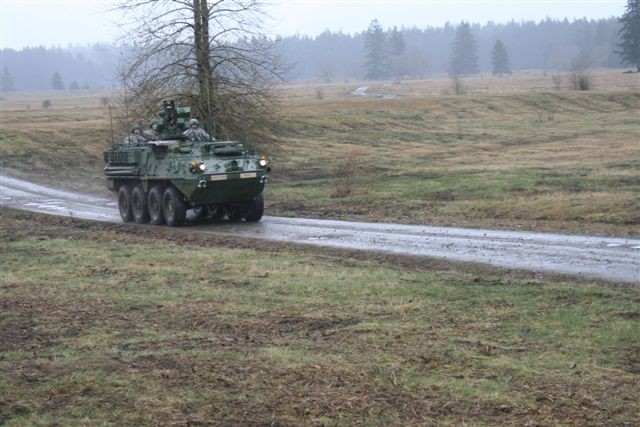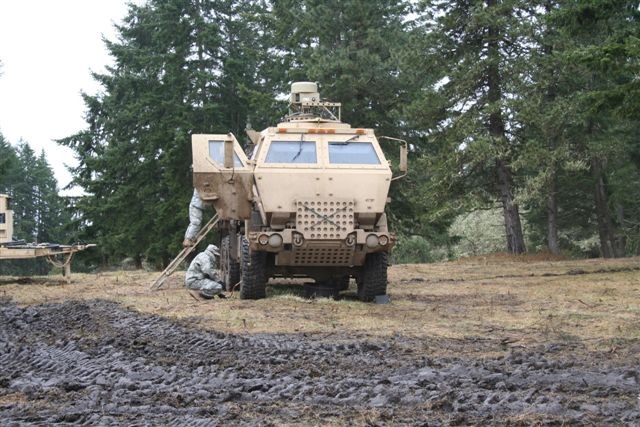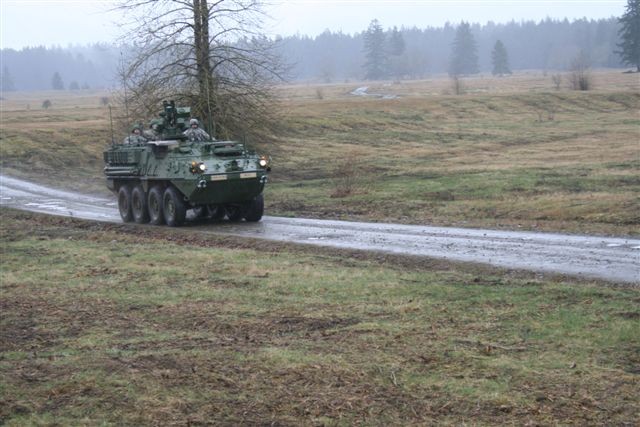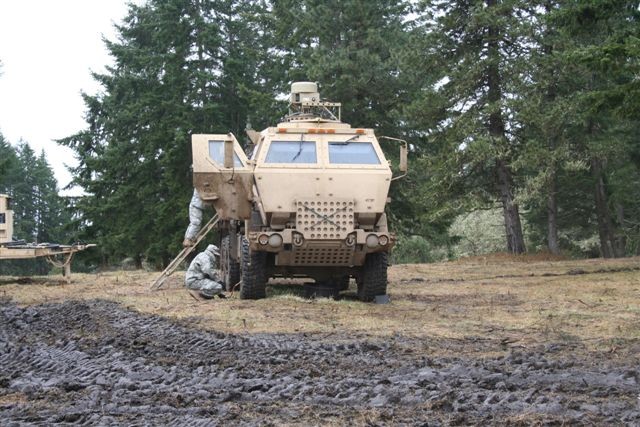FORT MONMOUTH, N.J. -- Throughout the Army's history, communications systems, such as radios and the Warfighter Information Network-Tactical (WIN-T) Increment One, have shaped the tactical Army's ability to move and support combat forces, said Maj. Gen. Nick Justice.
"Communications have allowed the speed of maneuver to increase," he added. "It has allowed us to support the forces from further distances and it has allowed fires to be coordinated from afar. So, with those three elements, basically, you've made distance less of a limiter. You've made speed an enabler and you have allowed sustainment to be global."
Now, WIN-T Increment Two, will further enhance these capabilities. Throughout its testing phases, Warfighters experienced the on-the-move communications, increased bandwidth, and enhanced security of this future WIN-T increment.
As Increment Two fields, it will allow Warfighters to communicate within their field of vision for the urban fights in places like Iraq or beyond the scope of their eyesight to the mountainous terrains like Afghanistan.
"We're really excited about WIN-T Increment Two, because it allows us to put terrestrial communications back in to that satellite network we fielded over the last few years and I need that redundancy and that fall-back position to make sure that Soldiers have all the capability they need in a high-intensity battlefield," said Justice, the Army's Program Executive Officer for Command, Control and Communications-Tactical (PEO C3T).
Today, WIN-T Increment One provides battalion-level-and-above Warfighters with the ability to connect to the Army's digitized systems, voice, data and video via satellite connections. Residing on this at-the-quick-halt communications pipe are the Battle Command systems that allow Warfighters to obtain real-time updates of their buddies' whereabouts over a topographical map, plan and execute fires, manage the airspace and share information such as intelligence, weather and terrain. Formerly known as the Joint Network Node-Network (JNN-Network), WIN-T Increment One officially became a program of record on June 5, 2008.
Col. William C. Hoppe, project manager for WIN-T, noted the significance of WIN-T Increment Two being tested by Soldiers for the first time since its official inception in June 2007.
"It's real, it's here, and it works," he said. "It is the first set of the equipment that's coming off the line, so we still have work to do to get where we want to go, but it's here today. This is no longer Powerpoint."
The introduction of satellite communications on-the-move will enhance operational capabilities for units, Justice said. Like present Stryker brigades, other units will have networks that can function continuously on-the-move.
Not only will they communicate while traveling from one location to the next, they can also plan the battle as they maneuver.
"It allows (Stryker brigades) to divert in the middle of a mission to another higher priority mission and plan en route," Justice said.
This will further align units with the Army Force Generation (ARFORGEN) model, which includes en route planning as a new capability requirement.
"You may not know what your mission is; so you have to be able to plan on route to your mission," Justice said. "It's about the speed of maneuver and being expeditionary."
Chief Warrant Officer Kevin Gonzalez also looks forward to the on-the-move capabilities WIN-T will bring to Stryker brigades, which he was worked with for four years.
"Information and dissemination of it is the key for Warfighters," said Gonzalez, an Army brigade network manager. "Knowing where the enemy is, knowing where any friendly adjacent units are, and being able to get real-time information or near real-time information down to the guy who is on the ground chasing down the enemy is what, we're here for. I think that where we're using now with this increment (Increment One) and going further. I think that we're able to deliver that to the Warfighter."
Increment One provides one of the three legs of the Army's Global Network Enterprise Construct (GNEC). The Regional Hub Nodes (RHN) are part of the Increment One program and provide what the Army's Chief Information Officer, Lt. Gen. Jeffrey Sorenson calls, "the connect". The Network Service Center is a component of the Army GNEC.
The Network Service Center construct will benefit units by providing a centralized server location for information shared across the network, said Brig. Gen. Jeffrey G. Smith Jr., commanding general, of the Army's 5th Signal Command (Theater) in Germany. This will allow users to tailor information sets to a specific unit or organization.
As WIN-T connectivity is provided down to the company level starting with Increment Two, this construct will let users rapidly obtain information packets that are tailored precisely to their circumstances from any location. Suddenly, the company commander will receive information concerning his or her next objective and will have the prodigious advantage of being able to participate in a broader common operating picture (COP), Smith said. A COP refers to the ability of separate commanders to share intelligence and data and access it through a common view.
The communications on-the-move capability of WIN-T will prove critical as the enemy situation constantly evolves on the battlefield, Smith said.
"So, in the old days you had to stop what you were doing, set up a communications capability, receive the information and then determine whether you were going to modify your course of action," he said.
"With WIN-T, you are able to immediately understand and apprehend the enemy's situation and evolve or modify your course of action, even as you are moving towards the objective. That's the great advantage in WIN-T and getting a tailored COP to a company commander who now oversees multiple individual platoon and team level missions. You can imagine the advantage. It's going to be huge," Smith said.
"The WIN-T system, as we are developing it, is a quantum leap over how a commercial user obtains satellite communications," said Rich Wexler, satellite communications lead engineer within MITRE Corporation's Fort Monmouth, N.J., office.
"To date, virtually all (commercial) satellite communication has been fixed satellite communications service."
Typically, this means a fixed dish is mounted on a roof or the side of a building for incoming or one-way communications, such as what satellite television users receive.
Some satellite providers offer two-way communications with Internet Protocol satellite and data communications capability.
"Our (Increment Two) systems provide full, duplex two-way communications and it provides it on-the-move," Wexler said. "So, we have taken two dramatic leaps over what is commercially available, because now we can provide communications anywhere in the world, on-the-move, both on improved roads and cross country terrain and we can do that at speeds well in excess of 25 miles per hour."
The story behind WIN-T Increment One began with the launches of 2001's Operation Enduring Freedom in Afghanistan and 2003's Operation Iraqi Freedom. The system was developed as an immediate response to the need for a beyond-line-of-sight communications pipe.
The need for that capability surfaced when now-retired Gen. William S. Wallace led the Army in a run for Baghdad.
Wallace recognized that the pace of the war outran the coalition forces' ability to communicate, which revealed a gaping hole in the way they fought. As the 3rd Infantry Division was deployed to Iraq, the need became evident for an evolution of Mobile Subscriber Equipment (MSE) network, the 20-year-old existing line of sight satellite communications network.
"We've already changed the Army's communications (system) once in the last six years, when we moved off of MSE to Increment One, or JNN," Hoppe said. "We're about to introduce that next step, that on-the-move capability, which is something that the Army's been after since the white paper came in after the original Five Corps run to Baghdad." Increment One is fielded to more than half of the Army.
The Increment Two Limited Users Test, held in December at Fort Lewis, Wash., with 4th Stryker Brigade/2nd Infantry Division, marked the first time Increment Two equipment was formally placed in the hands of Soldiers.
"Certainly, each unit that is today deployed in Iraq and Afghanistan has WIN-T Increment One which introduces a broadband IP (Internet Protocol) network to support the needs of division, brigade and battalion command posts," Weiss said. "But it is limited to static at-the-halt operations.
"So, with WIN-T Increment Two, this (was) the first time this system is really in the hands of Soldiers for a formal test. Increment Two brings that mobile network capability, which enables battle command and collaboration on-the-move."
In October 2008, an initial operational test and evaluation was held at Fort Lewis to demonstrate the operational effectiveness, suitability and survivability of Increment 1a to support a full rate production milestone decision. This was followed by an Increment 1b Limited User Test in March at Fort Stewart and Fort Gordon, Ga., in conjunction with the Increment Two Limited User Test to ensure that new capabilities inserted into Increment One are operationally effective, suitable and survivable.
The WIN-T Increment 1b Operational Test is scheduled for May of 2010. During Increment Two testing, a "build-a-little, test-a-little" strategy is being implemented to identify developmental issues early on and address them before moving on to more extensive testing.
This method was used when PM WIN-T successfully executed a 15 Node Engineering Field Test for Increment Two at Fort Dix, N.J., and Lakehurst, N.J., in October 2007. This was the largest Highband Network Radio demonstrated to date and showed the network's ability to perform dynamic routing on-the-move.
This strategy continued during the 30 Node Engineering Field Test, held at Fort Huachuca, Ariz., in December 2008.
That event demonstrated a larger network over a significantly sizable geographical area. Future tests for Increment Two will include Product Qualification Tests this October and March of 2010, along with an Initial Operational Test in July of 2010. PM WIN-T is assigned to the PEO C3T.
(This article appeared in Spectra, the magazine of the CECOM Life Cycle Management Command. To access the full issue in PDF format, 3.2 megabytes, click on the link appearing in the "Related Links" box at the start of the article.)




Social Sharing